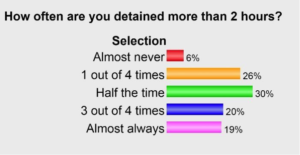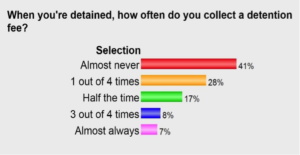By Mark Montague, Industry Rate Analyst, DAT Solutions
It’s been a few years since I sat in the dispatch chair or listened to a driver tell stories about delivery delays. Seeing the results and reading the comments on the recent DAT poll about driver detention felt like déjà vu. Nothing has changed!

Results from a DAT reader poll about truck driver detention
How Long Is Too Long?
When I started in trucking, most truckloads allowed two hours of free time. This was in 1981, shortly after deregulation of the motor carrier industry. Over the years, detention practices and fees might vary. During one period of slack freight, there was a push by shippers for three hours’ free time. Later, as driver recruitment got tougher, some motor carriers were pushing for 90 minutes or even an hour loading times, before the delay was considered to be detention.
But the basic problem with detention wasn’t the term or the payment per hour — or per 15-minute interval. It was getting the shipper or receiver to acknowledge that they had a problem at the dock. Any trucker will tell you that being paid for detention isn’t the goal. The goal is to be loaded and unloaded promptly, so the driver and equipment can be deployed efficiently.

Results from a DAT reader poll about truck detention
Changes on the Way
I think we have the beginning of a solution: the Electronic Logging Device (ELD) mandate. Combined with tracking software, the ELD can show the exact times when a carrier arrives at a shipper’s facility and when the carrier leaves. This negates the old argument about when a truck arrived. If we can get those delays recognized, they can become part of the negotiation. Then in order to get the best rates, the shipper or receiver actually has to do something to mitigate those delays. Freight brokers can take advantage of ELD data to advocate on behalf of the carrier. The most responsive brokers and shippers will win the loyalty of their preferred carriers when capacity becomes scarce again, as it inevitably will.
Using ELD data, a carrier can easily add up the hours of delay by customer. Then the economic cost can be evaluated not based on isolated instances, but based on the total experience with the account. The goal is not to collect more detention, but to recognize the true cost and to motivate the shipper to address root causes of delays at the dock.
Truckers Choice partners with DAT to offer a special on the TruckersEdge load board to its members. Sign up for TruckersEdge today and get your first 30 days free by signing up at www.truckersedge.net/promo154 or entering “promo154” during sign up.
* This offer is available to new TruckersEdge subscribers only
About TruckersEdge®, powered by DAT®
TruckersEdge® Load Board is part of the trusted DAT® Load Board Network. DAT offers more than 68 million live loads and trucks per year. Tens of thousands of loads per day are found first or exclusively on the DAT Network through TruckersEdge.
Note: This article was adapted from DAT’s blog post. It was first published in February, 2016.
